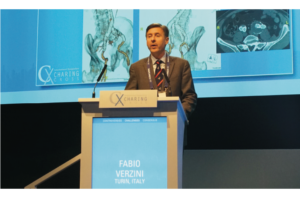
On Wednesday, during the Aortic Podium 1st session at Charing Cross (CX) Symposium, Fabio Verzini (Turin, Italy) reported that endovascular aneurysm repair (EVAR) with an iliac branch endoprothesis (Gore) is safe and effective. He added that the procedure was associated with improved quality of life in the short term and walking capacity was preserved.
“We know that if we perform EVAR, to occlude the iliac artery or to preserve it with an iliac branch. But if we do occlude the iliac artery, according to one paper, the risk of vascular complications is between 29% and 36%. Using a device to preserve the iliac artery is associated with favourable results [in terms of morbidity and mortality],” Verzini commented. He added that morbidity and mortality were not the only clinical outcomes of relevance in this context “as we need to have patient-reported outcomes”. Therefore, the aim of the present study was not only to confirm previous findings of EVAR with an iliac branch endoprothesis but also to “know what the patients think” about the procedure.
In the prospective, multicentre, single-arm study, 102 patients (mean age 75; all male) underwent EVAR with a minimally invasive iliac branch endoprothesis. The clinical endpoints were mortality, aneurysm-related mortality, the rate of reinterventions, and patency; the patient-reported outcomes were quality of life, walking ability, and erectile function.
The average procedure time was 147 minutes with an average fluoroscopy time of 41 minutes. Additionally, 75% of patients underwent the procedure via percutaneous access and 59% received local/regional anaesthesia. Overall, the technical success rate was 100%. At 30 days, mortality was 1% as was aneurysm-related mortality and the rate of iliac artery occlusion. Overall, 36% of patients had an endoleak, but, of those with an endoleak, only 1 had a type 1c endoleak. By one year, 3% of patients had died with no aneurysm-related mortality at this time point.
Furthermore, quality of life—as measure by the EQ5D score—was significantly improved at one month compared with baseline levels: 78±13 vs.74±16, respectively (p=0.035). At one year follow-up, quality of life scores had decreased but were still improved compared with baseline levels (although not to significant extent). Additionally, the percentage of patients without erectile dysfunction increased from 49% at baseline to 62% at one year (p=0.037).
Concluding, Verzini reported: “Aortoiliac endografting with the Gore iliac endoprothesis is safe and effective. Quality of life is positively affected by the intervention in the short term, walking capacity is preserved at one year, and erectile function is impaired in this elderly population and is slowly decreasing during follow-up.”













